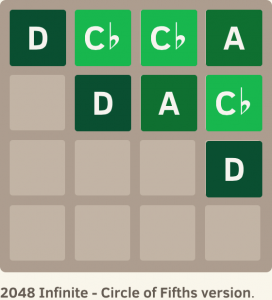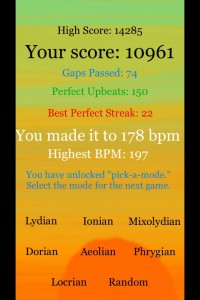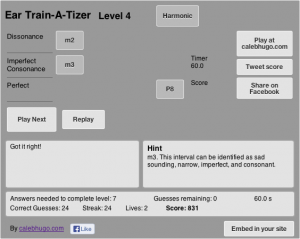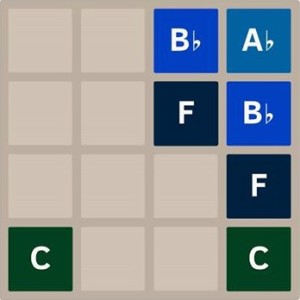 2048 Infinite – The Circle of Fifths is soon going to have a counterclockwise mode if the Kickstarter is funded. It’s going to sound very different, and here is why:
2048 Infinite – The Circle of Fifths is soon going to have a counterclockwise mode if the Kickstarter is funded. It’s going to sound very different, and here is why:
Going up a fifth repeatedly yields the clockwise circle of fifths. But what about down a fifth? Counterclockwise, of course, but can we really call it the circle of fifths at that point? It really depends on how you look at it. Taking cognition into account really messes the whole thing up.
Whenever we’re working with the raw materials of sounds, music theory should be looked at with a blank slate. No style in mind. Just air reverberating at certain frequencies. Get past all of your personal bias and look at sound the same way a machine would. Pure and cold objectivity (hey, that’s a great description of Stockhausen!).
This is sound we’re talking about! So, let’s listen to the circle of fifths counterclockwise:
Like I said before, I know that an inverted fifth is a fourth, and that there are fourths in the example. But remember; pure and cold objectivity. This means interval classes, not intervals. No tonicization means no hierarchy.
Just because it’s pretty sweet, here’s the tone row in fifths straight down in literal fifths:
Since I’m on a tangent anyway, serialism (the logical conclusion to 12-tone music) is the attempt at eliminating the hierarchy of pitches in music. It is to balance the sonic spectrum. The previous example does not do this. It makes the C at the end the most important note and the note we remember. This does not give us an accurate impression of what the circle of fifths sounds like.
Back to the circle of fifths! Compare the counterclockwise circle of fifths to the clockwise circle of fifths:
Presented in this pure and unbiased form, they sound very similar. Comparable harmonic material results. For all practical theoretical purposes, the counterclockwise circle of fifths is still the same circle of fifths. Just in retrograde.
But then we make music out of it and everything changes. Particularly the bass…which it why everything changes. Here is the Berg style tone row from last time…backwards! And I mean really really backwards; I forgot to save the MIDI and only had the mp3 file to work with:
Here it is forwards for comparison:
Hear how the middle is a lot crunchier than it is when it’s backwards?
The Counterclockwise Circle of Fifths and Perceived Bass
The bass is quite literally the harmonic foundation and context for everything else you hear in a musical texture. So, the dissonance made out of a counterclockwise circle is welcome because the perceived bass is constantly changing to meet the new sounds. We don’t have to change the bass because our ears do the work or us.
Why do our ears do this? The ratio of the frequencies caused by the notes that make a fifth are 2:3. In other words, the sound waves line up every three oscillations of the higher note. This ratio is easier to understand than the 3:4 ratio of the fourth. Since the fifth’s ratio is simpler, our brains are more drawn to that sound and automatically rearrange any fourth they hear into the simplest ratio. This is possible because the octave above any given note is actually present in the sound via the harmonic series. Our brains reorchestrate sounds into their simplest ratio, and this changes the perceived bass as we go backwards in the circle.
We can also approach it from tonal theory when we are thinking melodically. An ascending melodic fifth (clockwise) ends on the note the ear perceives as least important. This means it sounds unresolved as opposed to the descending fifth (counterclockwise) which ends on the important sounding note (tonic). Here it as ascending:
And now descending, which is the one that sounds resolved and therefore less dissonant (Isn’t the Xylophone sweet):
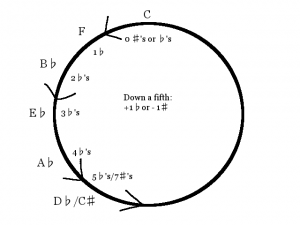 So counterclockwise fifths are persistently resolving to each other. It puts the music in a state of perpetual resolution. As opposed to clockwise which puts the music in a state of perpetual tension.
So counterclockwise fifths are persistently resolving to each other. It puts the music in a state of perpetual resolution. As opposed to clockwise which puts the music in a state of perpetual tension.
Basically, fifths are actually fourths because of some crazy cognition stuff, and going backwards in the circle fixes all dissonance.
So, is it fifths or fourths? If you take cognition into account, it’s fifths. In fact, it’s even more fifths than clockwise. Clockwise is really the awkward direction.
Here is that cool improvisation from last time–backwards! And therefore more resolved:
If all of this stuff sounds jazzy, you are correct. Now listen to Bill Evans.


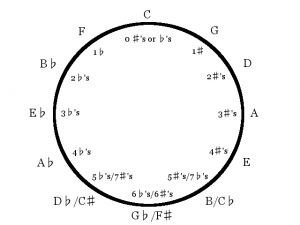 The
The 